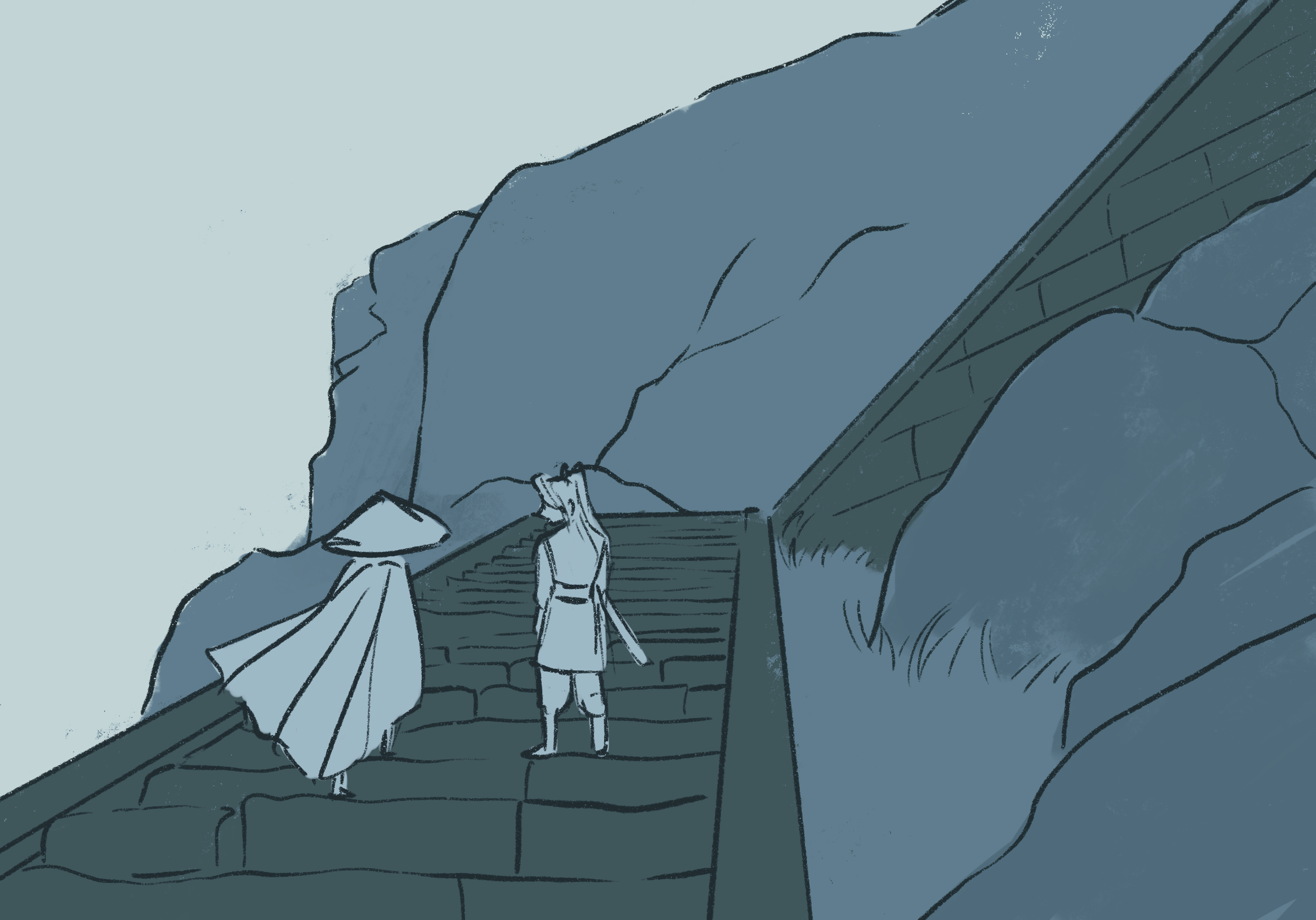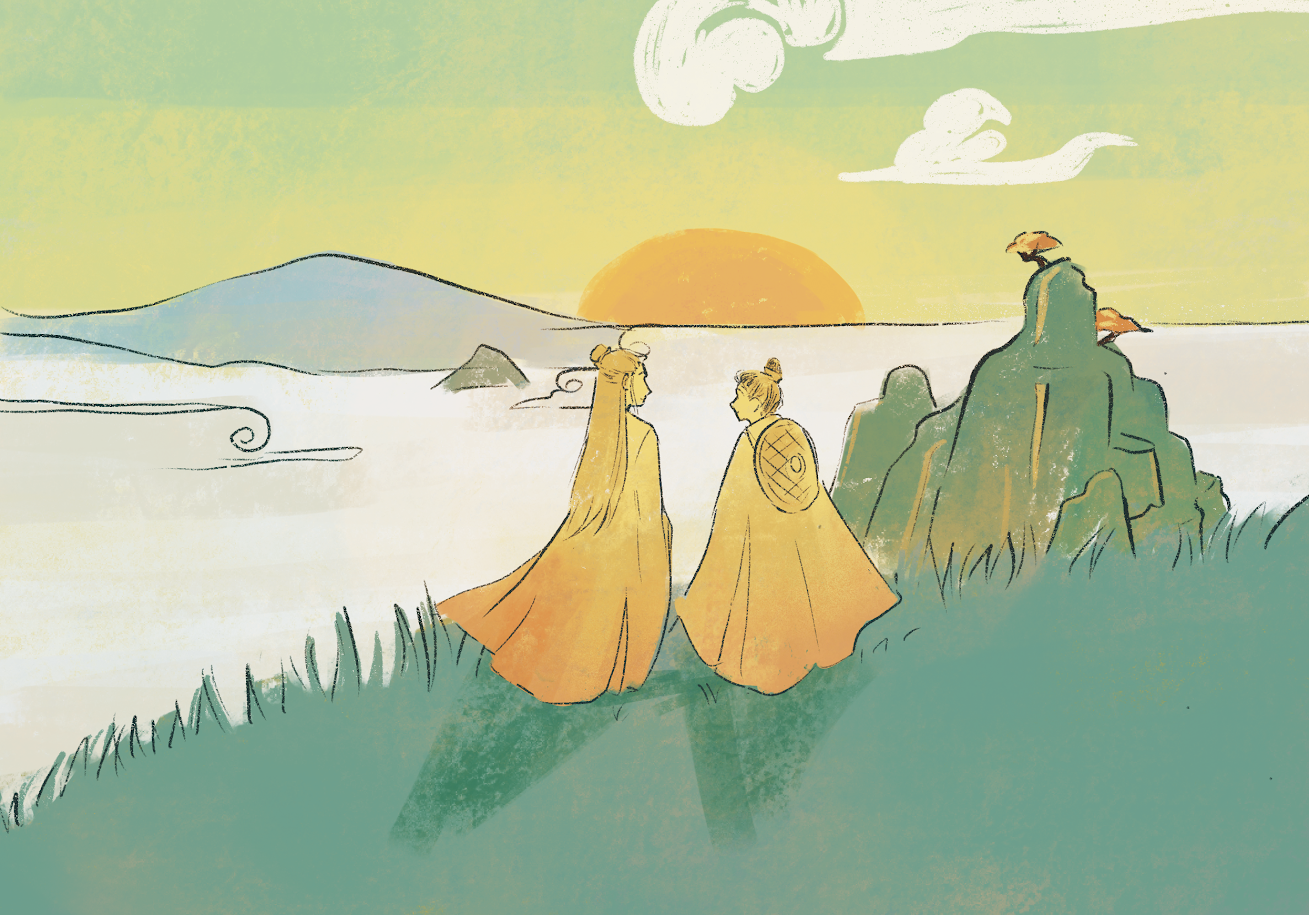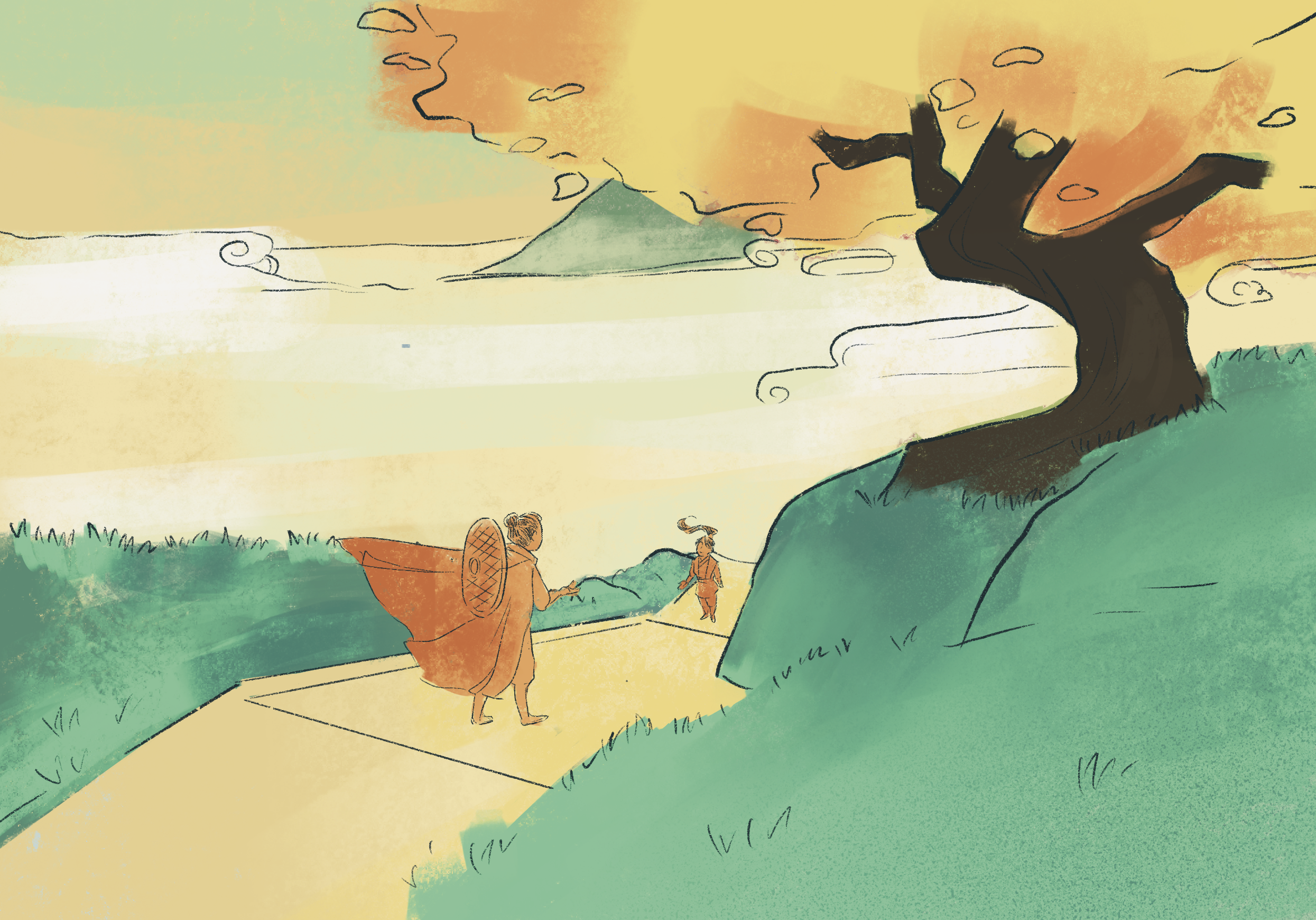

Introduction to Yun
Yun is a dating simulator game set in ancient China. Its current title means jade in Chinese (foreshadowing!). You begin the game as a travelling scrap-collector, who comes upon a mysterious stone statue in the mountains. You are given the opportunity to discover the mystery behind it. Accompanying you are Mingyu, the honor-bound rogue cultivator, and Lan, the sect leader whose smile hides more than he lets on.
General Thoughts
When I began thinking about what kind of game I wanted to create, I knew I wanted art and my cultural background to play a role. Given the limited time, I thought designing a dating simulator game set in ancient China would be fun to create. I wrote the game to follow the popular Chinese fantasy genre known as xianxia, where one can train to such an extent that they may ascend to immortality and gain godlike powers. However, I knew not everyone playing this game would know what was going on.
Initially, I was writing a story for myself, and not considering how the narrative would appeal to a broader audience. As I haven’t done much beta testing, most narrative games I’ve played are at a polished level of development and consequently require almost no effort to enter. The painstaking efforts of the game developers mean that players can easily become a part of that fictional world, without thinking about the gears behind the scenes. The story flows without a hitch. I wanted to set my game in ancient China, but an initial struggle was how I would relay the rich history of Chinese fantasy to those without knowledge of the genre. This problem was augmented by the interactive nature of the game—whereas someone could gradually pick up knowledge from watching TV shows and movies in third person, a game directly thrusts them into that world as a person with influence and assumed familiarity. How could I empathize beyond my personal cultural experiences to view what someone else would or would not understand? I hope that my inclusion of a glossary, as well as attempts to weave the background into the art, will help players who aren't as familiar.
Environment and Character Design
As an aspiring artist, my first impression of anything is usually its aesthetic appeal. The visual design of my game was, as a result, very important to me. I was particularly interested in using art to build a fictional world, as it was something I had never attempted before. I am also very interested in environmental design over character design, so I spent a lot of time looking at previous examples of Chinese fantasy landscapes.
I set some initial restrictions for the sake of scope, such as a limited color scheme and a set number of backgrounds. Because the philosophy of Chinese cultivation typically centers around meditation and inner reflection, I chose a blue palette to emulate feelings of peace. Since mountains are associated with immortality and tranquility in Chinese culture, I set my game in the deep mountains, high above the clouds. And because it would be a cultivation story, where there is a focus on immortality and other fantasy elements, I wanted to emulate mystical imagery as well as heaven and earth. The nature of my game, in which progression was dictated by clicking, made it difficult to transition to a dynamic composition mindset. But I attempted to draw clear visual pathways to guide the player as if they had mobility. However, I haven’t really seen this method of drawing environmental pathways in dating simulator games, which usually rely on character expressions within flat settings, with the occasional highly detailed illustration during key developments. As an amateur, I don’t know then if this visual choice clashes with the dating simulator aspect of my game. There is still much to learn!

One concept in class readings that particularly stuck with me was the use of shape, especially the contrast of character shapes with their environment. I had decided first that my game environment would be tranquil, so I had to think about how my character shapes would contrast. Following the article, I designed my character Mingyu, who has an abrasive, angrier personality to have sharper angles, achieved through facial features and closer-fitted clothing. I designed my second character, Lan, to look calm and wise, with flowing robes that matched the atmosphere. I also designed them this way to imply that Mingyu does not fit, which is later revealed to be true in the plot.
I would like to keep working on this game after this course is over. I wonder how the visuals would evolve with improvement of my art skills. I struggled a lot with creating dynamic settings, especially character gestures and expressions. I also really struggled with creating cutscenes, as I realized belatedly that creating animatics requires a strong foundation of motion, storyboarding, and more. This experience made me recognize how much there is to learn. Perhaps in future versions, after more research into the Chinese fantasy genre, I could begin to study how animation influences the viewer experience, and how movement defines our perception of the game’s world. For example, I would love to animate some fight sequences or magical beasts—but first I must learn to animate! I must also add 3D modeling to my bucket list in my game-making journey. World-building is definitely much more complicated than it appears to be.
Playtesting

After collecting data from six playtesters, I was able to get a much better view of my story as a whole. The playtesters helped me fix audio glitches and code bugs, but they also offered valuable insight into the overall player experience. The most common feedback was that there was not time created for the player to get to know the world and the two romanceable characters before reaching an ending. This made a lot of sense since I had to condense many of my initial ideas down into a feasible product for a final project. But I do see how the scope of my plot may have been too ambitious for the time the player spent within the world. Additionally, any relationship requires time to grow, which I'm afraid wasn't maximized in this game because I wasn't able to write enough individual scenes for my two main characters.
I also got feedback about the story bias towards Lan, the second romanceable character you meet. The game was structured to play through specific scenes, and give players the choice to alternate between which character they wanted to spend time with. But the limited number of scenes I had written meant that Mingyu's storyline had more pipelines to Lan's storyline than vice versa, and therefore players didn't get a chance to interact with Mingyu as much. Additionally, if one spent most of the game interacting with Lan, it was still possible to get Mingyu's ending--but the emotional impact would be significantly less than if they had gotten to know her more. I think this is one of those issues that can be solved by increasing scope and a significant amount of rewriting--one that ensures the player is able to know all the relevant plot information, while simultaneously building relationships with both characters.
All my playtesters expressed an appreciation for the art and Chinese fantasy aspect, stating that it helped them enter the story. The xianxia vocabulary was not a problem, and when I asked if using the glossary was a significant distraction from the gameplay, all of them said they felt the glossary helped a lot and was not disruptive. However, I do think that the information presented in the glossary could potentially be woven into the gameplay if the game was longer.
In the end, I think that my storyline slightly overshadowed the dating aspect of the game, which I don't think is necessarily a bad thing. However, I do believe my story was extremely rushed and still have a lot of ideas for how it could be written better. For example, one playtester mentioned that a lot of information is dumped on them in one scene right before the big climax, which was a result of me not being able to slowly ease that worldbuilding in the preceding scenes. I think, given more time, I would love to continue to flesh this world out and give it more character. I definitely want to continue developing Mingyu, Lan, and future characters, deepening their personal history and pathos.
Final Thoughts
I definitely realized how much work goes into making a game during this project. Even in this simple narrative, I had to draw a crazy number of images, spend hours debugging and fixing plot holes, and trying to figure out if the story made sense or was appealing at all. Creating a game is definitely a remarkable feat, but it has inspired me to continue learning about game design and working on this game in the future.